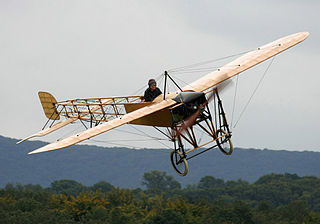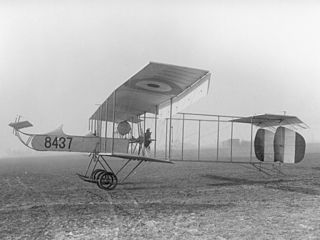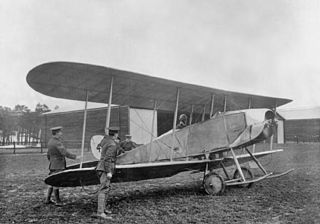Related Research Articles

The Boxkite was the first aircraft produced by the British and Colonial Aeroplane Company. A pusher biplane based on the successful Farman III, it was one of the first aircraft types to be built in quantity. As the type was used by Bristol for instruction purposes at their flying schools at Larkhill and Brooklands many early British aviators learned to fly in a Boxkite. Four were purchased in 1911 by the War Office and examples were sold to Russia and Australia. It continued to be used for training purposes until after the outbreak of the First World War.

The Blériot XI is a French aircraft of the pioneer era of aviation. The first example was used by Louis Blériot to make the first flight across the English Channel in a heavier-than-air aircraft, on 25 July 1909. This is one of the most famous accomplishments of the pioneer era of aviation, and not only won Blériot a lasting place in history but also assured the future of his aircraft manufacturing business. The event caused a major reappraisal of the importance of aviation; the English newspaper The Daily Express led its story of the flight with the headline "Britain is no longer an Island".

Blériot Aéronautique was a French aircraft manufacturer founded by Louis Blériot. It also made a few motorcycles between 1921 and 1922 and cyclecars during the 1920s.

The Royal Aircraft Factory F.E.1 was designed and built in 1910 by the pioneer designer Geoffrey de Havilland. He used it to teach himself to fly during late 1910. After De Havilland was appointed assistant designer and test pilot at the Army Balloon Factory at Farnborough in December 1910 the War Office bought the aircraft for £400. the aircraft was given the designation F.E.1

The Avro Type D was an aircraft built in 1911 by the pioneer British aircraft designer A.V. Roe. Roe had previously built and flown several aircraft at Brooklands, most being tractor layout triplanes. The Type D was his first biplane.

The Avro Type E, Type 500, and Type 502 made up a family of early British military aircraft, regarded by Alliott Verdon Roe as his firm's first truly successful design. It was a forerunner of the Avro 504, one of the outstanding aircraft of the First World War.

The Bristol Gordon England biplanes were a series of early British military biplane aircraft designed by Eric Gordon England for the Bristol Aeroplane Company that first flew in 1912. Designed for easy ground transport, the aircraft could be quickly disassembled.
The Grahame-White Baby was an early British aircraft designed by pioneer aviator Claude Grahame-White in 1910.

The Farman III, also known as the Henry Farman 1909 biplane, was an early French aircraft designed and built by Henry Farman in 1909. Its design was widely imitated, so much so that aircraft of similar layout were generally referred to as being of the "Farman" type.

The Short S.27 and its derivative, the Short Improved S.27, were a series of early British aircraft built by Short Brothers. They were used by the Admiralty and Naval Wing of the Royal Flying Corps for training the Royal Navy's first pilots as well as for early naval aviation experiments. An Improved S.27 was used by C.R. Samson to make the first successful take-off from a moving ship on 9 May 1912.

The Short S.38 was an early British aircraft built by Short Brothers.

The Royal Aircraft Factory B.E.3 was a single-engined rotary engined biplane developed by the British Royal Aircraft Factory prior to the First World War. The B.E.4 and B.E.7 were virtually identical aircraft that differed only in the engine fitted.

The Howard Wright 1910 Biplane was an early British aircraft built by Howard T. Wright to a design by W.O. Manning. One was used by Thomas Sopwith for his early record-breaking flights. Another made the first powered flight in New Zealand.
The Short S.80 was an early British floatplane built by Short Brothers for Frank McClean to undertake an aerial expedition up the Nile to investigate the cataracts between Aswan and Khartoum. After a successful flight to Khartoum it was returned to England, where it was used for training by the RNAS. When built it was the largest successful aircraft that had been constructed in Britain. It was also known as the Short Nile Pusher Biplane Seaplane.
The Bristol P.B.8, or Bristol-Coanda P.B.8', was an early British-built, Romanian-designed two-seat biplane trainer made by the Bristol Aeroplane Company in 1914. Only one was completed, which was never flown.

The 1910 Deperdussin monoplane, also known as the Deperdussin Type A, was the second Deperdussin aircraft. It was released in August 1910 and was the first aircraft to be built in significant quantities by Aéroplanes Deperdussin. Together with variants Type B and Type C, a number of aircraft were flown successfully in air races and gained several records during 1911–1912. Several have survived, including an airworthy example in the Shuttleworth Collection in England.

The Voisin Type de Course was an early French aircraft built by Voisin Frères. It was first flown early in 1910.
Graham Gilmour was a British pioneer aviator, known for his impromptu public displays of flying. He was killed on 17 February 1912 when his Martin-Handasyde monoplane suffered a structural failure and crashed in the Old Deer Park in Richmond, London.

The Paulhan biplane was a French experimental aircraft designed in 1910 by the successful aviator Louis Paulhan in collaboration with Henri Fabre. The prototype became the second aircraft bought by the British War Office: two further examples, differing in constructional detail, were built.

The pioneer era of aviation was the period of aviation history between the first successful powered flight, generally accepted to have been made by the Wright Brothers on 17 December 1903, and the outbreak of the First World War in August 1914.